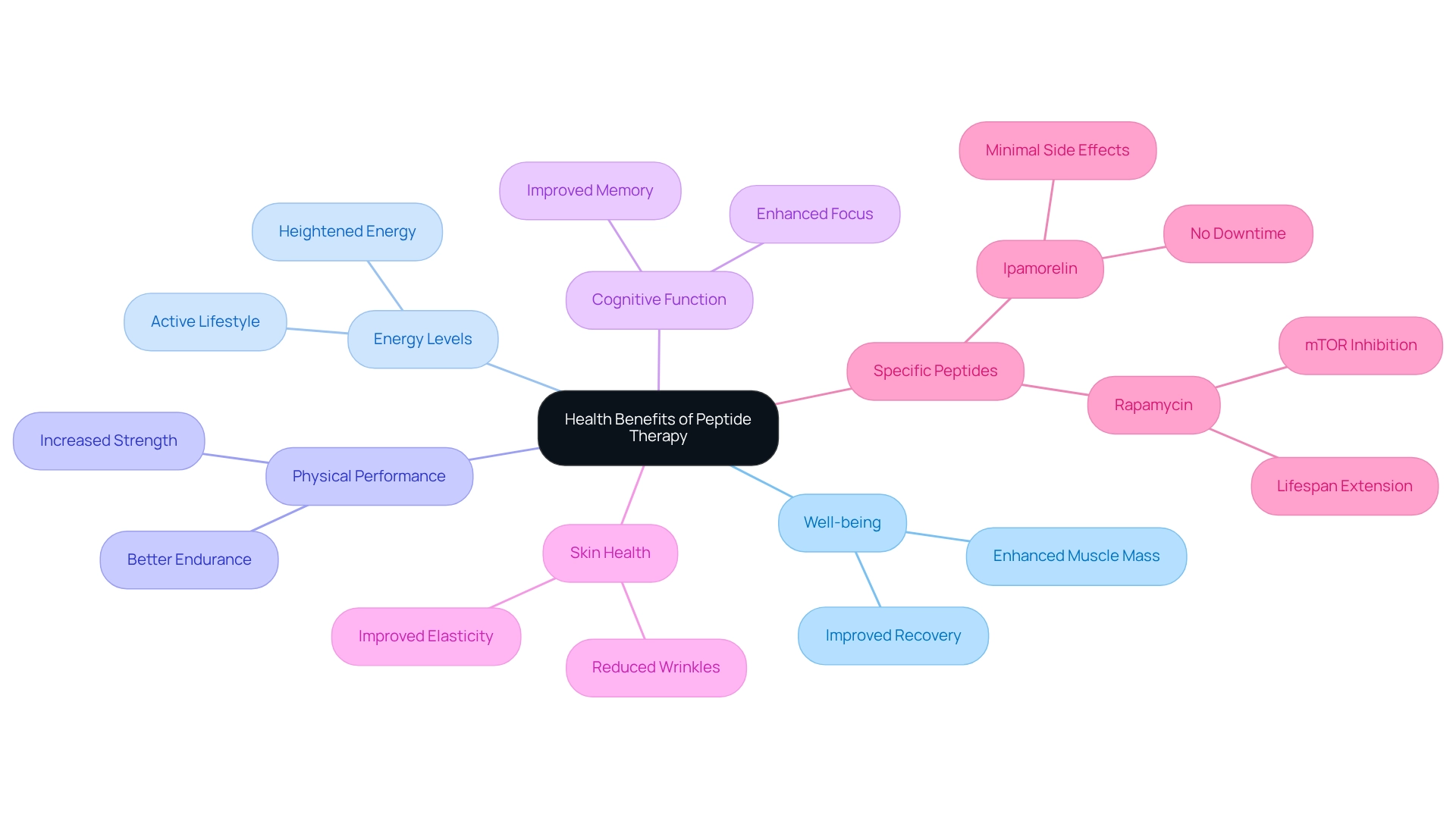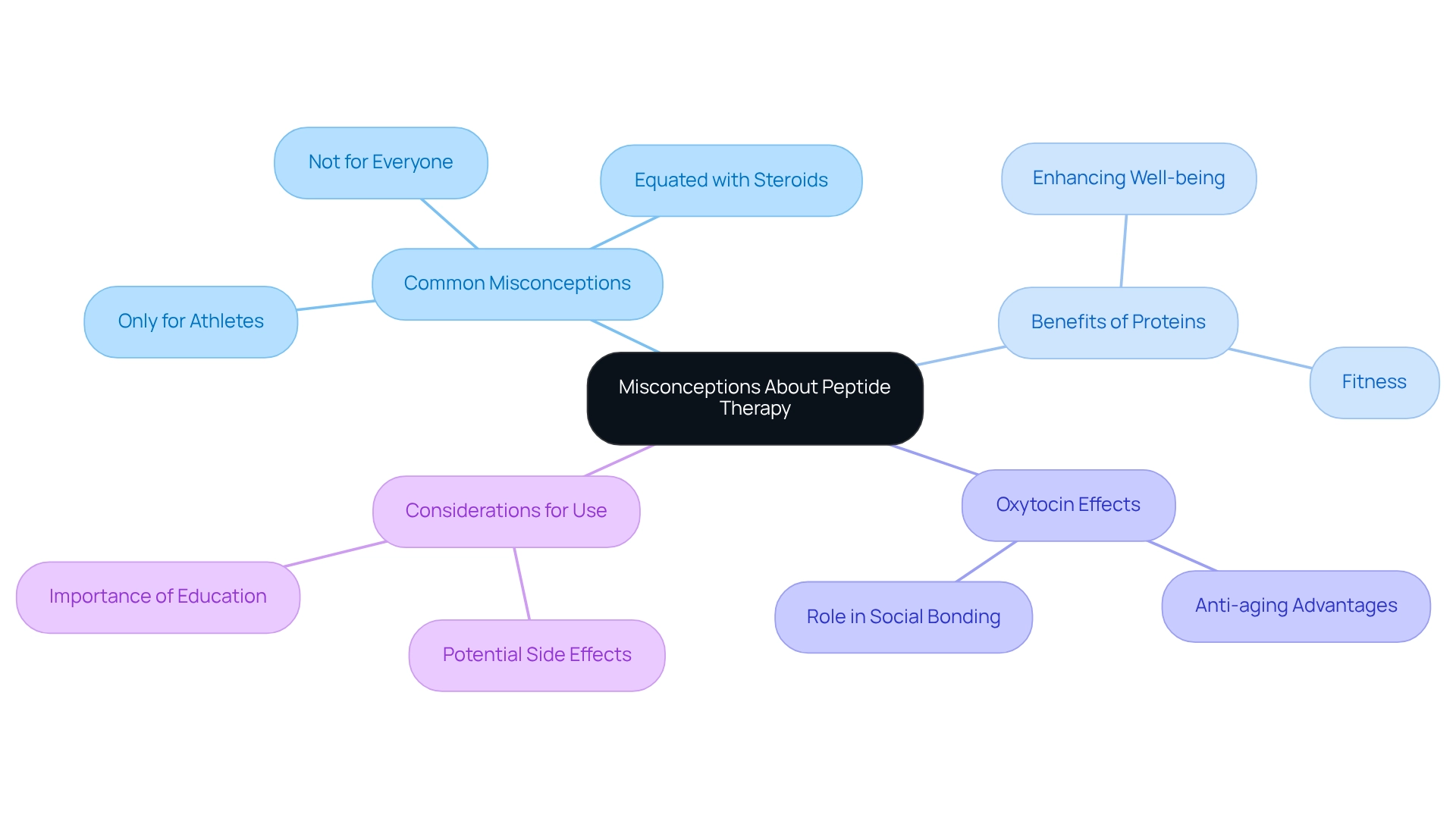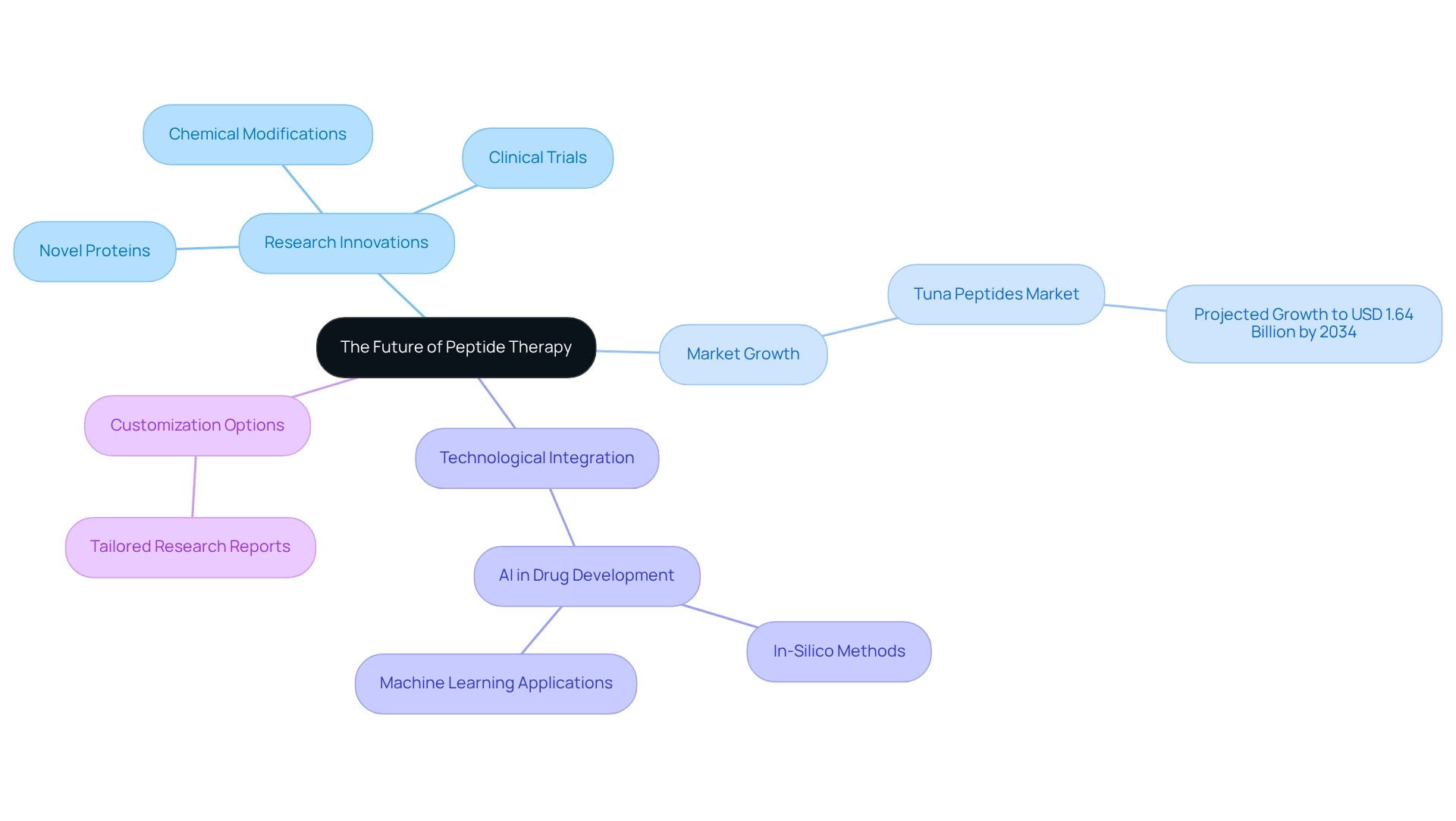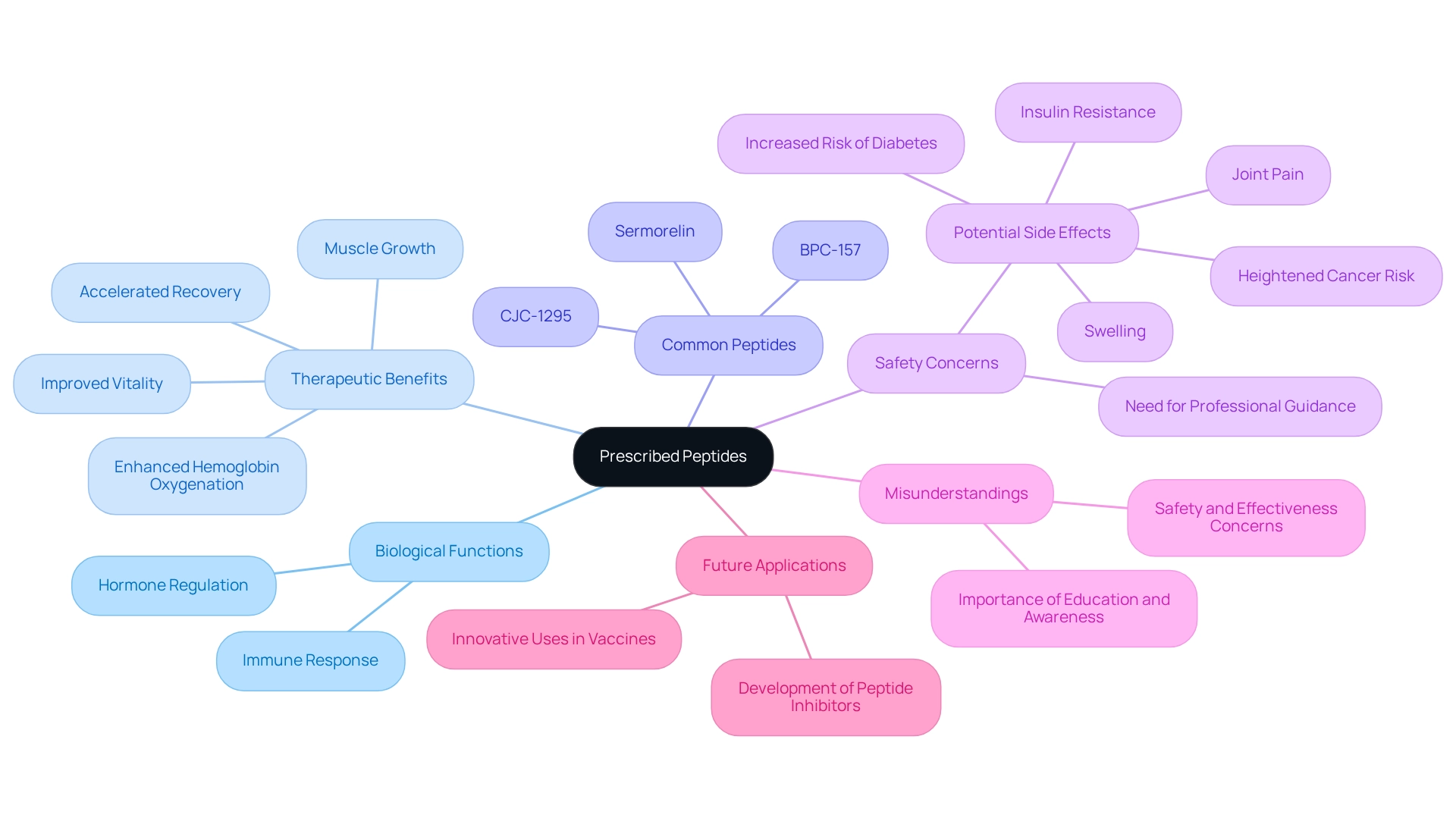7 Essential Facts About Prescribed Peptides for Wellness
Overview
Prescribed peptides play a significant role in wellness by promoting muscle growth, enhancing recovery, and improving overall vitality through various biological functions. How do these peptides achieve such effects? They stimulate hormone regulation and bolster immune response, which are vital for maintaining health. Furthermore, their therapeutic benefits, including tissue repair and metabolic improvement, are essential for individuals seeking to enhance their health and longevity. By understanding the multifaceted advantages of prescribed peptides, one can appreciate their importance in a health-focused lifestyle.
Introduction
In the quest for longevity and vitality, peptide therapy has emerged as a groundbreaking approach that integrates seamlessly into anti-aging strategies. Peptides, the building blocks of proteins, hold the potential to rejuvenate biological functions that typically decline with age. This offers a non-invasive solution for those seeking to enhance their health. With compelling research supporting their efficacy in stimulating collagen production and improving skin elasticity, peptides are gaining recognition not just for their cosmetic benefits but also for their role in overall wellness.
As individuals become increasingly aware of the health advantages associated with peptides, the conversation around innovative therapies continues to evolve. This encourages a holistic approach to aging gracefully. This article delves into the multifaceted world of peptide therapy, exploring its benefits, applications, and the importance of expert guidance in navigating this promising field.
ByKomi: Integrating Peptide Therapy into Anti-Aging Strategies
ByKomi.com emphasizes protein-based treatments as a vital component in anti-aging approaches. Prescribed peptides, which are short chains of amino acids, play a significant role in stimulating biological processes that typically decline with age. This groundbreaking treatment has gained popularity due to its non-invasive characteristics and safety for a majority of skin types, making it an attractive choice for individuals looking to boost their vitality.
Studies show that this method can effectively stimulate collagen production and enhance skin elasticity, tackling common signs of aging. In clinical observations, patients receiving protein treatment reported remarkable decreases in wrinkles and fine lines, with studies indicating that around 75% of participants saw substantial enhancements in their skin conditions. Moreover, medical experts have observed that prescribed peptides can enhance resistance to infections and promote faster recovery from ailments. Mishra et al. documented improved recovery rates among patients undergoing peptide treatment, emphasizing the treatment’s potential benefits.
Alongside peptide treatment, ByKomi.com highlights the significance of nutrition in its comprehensive approach to wellness. For example, the addition of nutrient-dense recipes, like beef liver patties, demonstrates how organ meats can deliver vital vitamins and minerals that promote overall well-being and vitality. The beef liver patties contain:
- 550 calories
- 45g of fat
- 40g of protein
- 0g of carbohydrates
This extensive perspective enables individuals to embrace effective approaches for sustaining well-being as they age.
Furthermore, the increasing fascination with low-dose naltrexone (LDN) as a groundbreaking treatment for anti-aging is significant. LDN is recognized for its safety and tolerability profile, presenting fewer side effects than many other treatments. Side effects are generally mild and transient, often resolving as the body adjusts to the medication. ByKomi.com incorporates these insights into its dedication to informing its audience about the latest research and practical uses of both hormone treatments and LDN, establishing it as a significant resource for those committed to aging gracefully. For those interested in exploring these therapies, consulting with a healthcare professional can provide personalized insights and options tailored to individual health needs.
Understanding Peptides: What They Are and How They Work
Chains of amino acids, typically ranging from 2 to 50 connected by bonds, are known as peptides. These biomolecules are fundamental to numerous biological functions, including hormone regulation, immune response, and tissue repair. By mimicking or enhancing the body’s natural functions, peptides can restore equilibrium and promote recovery, making them particularly beneficial in the context of aging.
It is important to note that these compounds differ from steroids; while prescribed peptides are chains of amino acids, steroids are ring-shaped fatty molecules. Recent studies underscore the significant growth potential of prescribed peptides in addressing unmet medical needs. They are positioned as modular components for constructing multifunctional molecular therapies, akin to LEGO™ bricks.
For instance, research on antimicrobial compounds, as discussed in the case study titled ‘Antimicrobial Compounds as Antibiotic Alternatives,’ is exploring their viability as substitutes for traditional antibiotics, especially given the rise in antibiotic resistance. These compounds show promise as a new class of therapeutics, although further research is required to fully understand their effectiveness and safety.
In addition to their therapeutic promise, recent insights into oxytocin supplementation reveal its anti-aging benefits, linking it to improved social bonding and overall well-being. Understanding how proteins function within the body is crucial for recognizing their potential benefits for health and vitality.
Proteins operate by interacting with specific receptors, influencing various physiological processes, and thereby contributing to overall well-being. As the scientific community continues to investigate the biological roles of these molecules, the applications of prescribed peptides in hormone regulation and health maintenance are becoming increasingly clear, paving the way for innovative therapeutic strategies.
We acknowledge Maria Juul Kolding for her technical support.

Medical Applications of Peptides: Therapeutic Uses and Benefits
Prescribed peptides are increasingly recognized for their diverse medical applications, especially in hormone replacement therapy, weight management, and anti-aging treatments. Notably, substances like Sermorelin and CJC-1295 play a vital role in stimulating growth hormone production, greatly enhancing muscle development and aiding in fat reduction. Furthermore, compounds such as BPC-157 are renowned for their extraordinary healing attributes, promoting tissue restoration and recovery following injury.
The therapeutic capabilities of these substances extend beyond these instances. Current research indicates that the field of prescribed peptides as peptide-based drugs is still evolving, with many promising targets yet to be explored. As of 2025, ongoing clinical trials continue to illuminate the effectiveness of various compounds, notably prescribed peptides, in treating age-related conditions, underscoring their significance in anti-aging strategies. Significantly, the success of underwater research, such as Dr. Dituri’s 100-day underwater experiment, which showcased considerable physiological adaptations and potential wellness advantages, suggests that extended underwater living may provide further insights into well-being and longevity. Future research could explore how lifestyle modifications, including nutrition and physical activity, when paired with specialized treatments, could enhance anti-aging benefits.
It is noteworthy that Dr. Hyman’s podcast, The Dr. Hyman Show, has achieved over 150 million downloads, reflecting the growing interest in specialized treatments among health-conscious individuals.
Practical applications of these treatments for weight control have shown promising outcomes, with individuals reporting substantial improvements in body composition and metabolic wellness. However, it is crucial to approach protein treatment with caution, as potential side effects may arise, particularly with unregulated supplements. A case study underscores that while protein treatment is typically safe, individuals should consult healthcare professionals to ensure safe and effective application, being mindful of potential allergic reactions and other side effects.
Expert opinions highlight the increasing acknowledgment of proteins in functional medicine. Dr. Edwin Lee, a functional medicine doctor, emphasizes the necessity for further research to fully understand their benefits and applications. As the landscape of protein treatment continues to expand, it offers a hopeful path for enhancing overall wellness and well-being, especially when combined with innovative strategies from ongoing studies into lifestyle factors and their impact on aging.

Health Benefits of Peptide Therapy: Enhancing Wellness and Vitality
The benefits of prescribed peptides in peptide treatment greatly improve well-being and energy. By promoting the release of growth hormones, prescribed peptides play a crucial role in counteracting age-related issues such as muscle loss and reduced energy levels. This treatment not only helps enhance muscle mass and recovery but also elevates cognitive function and skin health, contributing to overall physical performance, especially when incorporating prescribed peptides. Recent insights suggest that individuals receiving prescribed peptides often experience heightened energy levels, which can result in a more active lifestyle. For example, case studies have indicated that patients using ipamorelin treatment report minimal side effects and can promptly return to their daily activities, provided they implement suggested lifestyle changes—such as including regular exercise and a balanced diet—to enhance treatment results.
Furthermore, rapamycin has become a notable factor in the anti-aging field. Originally discovered in soil bacteria, rapamycin functions as an inhibitor of the mTOR pathway, which regulates cellular growth and metabolism. By modulating processes involved in aging, such as protein synthesis, autophagy, and mitochondrial function, rapamycin has shown promise in extending lifespan and improving healthspan across various model organisms. Its ability to improve age-related illnesses, such as cancer, neurodegeneration, and heart disease, further highlights its significance in the pursuit of longevity.
Statistics indicate that wellness centers focusing on such treatments, like Allura MedSpa, have received over 300 positive reviews, emphasizing the increasing acceptance and effectiveness of these methods. This trend underscores the growing acknowledgment of protein treatment as a feasible choice for boosting vitality and general well-being. Specialists in the area, including practitioners from Seattle Plastic Surgery, highlight the importance of consulting qualified medical professionals to customize treatments to personal wellness profiles, ensuring safety and effectiveness.
As we approach 2025, the advantages of protein-based treatments continue to gain acknowledgment, with many individuals reporting notable enhancements in muscle mass and energy levels. Real-world examples demonstrate how prescribed peptides not only enhance physical health but also promote a sense of well-being, making them a desirable option for individuals dedicated to improving their health and longevity. The combination of treatments such as rapamycin with proteins may provide a comprehensive method to address age-related deterioration and improve overall vigor.

Side Effects of Peptide Therapy: What to Expect
Peptide treatment is generally considered safe; however, some individuals may experience side effects. The most frequently reported side effects include injection site reactions, such as redness and swelling, along with nausea and fatigue. Typically, these effects are mild and transient, often resolving without intervention. Research suggests that a considerable proportion of patients encounter these side effects, with studies demonstrating that the frequency can differ depending on the particular compound used and individual patient factors.
For instance, a recent study emphasized that while many patients manage exenatide treatment effectively, about 45.4% of those receiving it weekly reported experiencing some type of side effect after 52 weeks. This underscores the importance of monitoring and adjusting treatment plans as necessary. Healthcare experts suggest seeking advice from a qualified provider before starting this treatment to discuss possible risks and customize the approach to individual health requirements. Proper guidance is essential, particularly considering the limited evidence regarding the effectiveness and safety of different protein supplements.
As noted by Marie Lorraine Johnson, MS, RD, CPT, ‘Currently, there is still limited evidence to indicate that these products are effective, and much more research is necessary to assess their efficacy and safety thoroughly.’ Comprehending what to anticipate when beginning protein therapy can greatly improve the overall experience and results for patients. Additionally, it is advisable to decrease sulphonylurea or insulin doses when starting a GLP-1 receptor agonist to reduce the risk of hypoglycemia.
Furthermore, adhering to package instructions and consulting healthcare professionals, as highlighted in the case study ‘Guidelines for Using Peptide Supplements,’ is essential for safe usage. As investigation into prescribed peptides is still in its early stages, upcoming studies may uncover further health advantages.

Commonly Prescribed Peptides: A Guide to Popular Options
Among the most frequently prescribed peptides are:
-
Sermorelin: This peptide stimulates the release of growth hormone, which is crucial for muscle growth and fat loss. It is a popular choice for those looking to enhance physical performance. To maximize its benefits, consider incorporating strength training into your routine.
-
BPC-157: Recognized among prescribed peptides, it is renowned for its remarkable healing properties and supports tissue repair and recovery. This peptide proves beneficial for athletes and individuals recovering from injuries. Pairing it with a balanced diet rich in nutrients can further support recovery.
-
CJC-1295: A type of prescribed peptide that promotes increased muscle mass and aids in fat loss by enhancing growth hormone levels. This aligns with fitness goals for many users. Significantly, it is also recognized to enhance sleep quality, which is crucial for overall wellness and recovery. Establishing a consistent sleep schedule can enhance its effectiveness.
-
Ipamorelin: Classified as one of the prescribed peptides, it acts as a growth hormone secretagogue that not only helps increase muscle mass but also improves recovery times and sleep quality. This makes it a favored option among fitness enthusiasts. Incorporating relaxation techniques before bedtime can further improve sleep quality.
As stated by writer Tolu Ajiboye, “Peptides possess antioxidant, antimicrobial, and antithrombotic (anti-clotting) effects, among others,” highlighting their diverse benefits. These compounds are frequently employed in conjunction with lifestyle changes, such as a balanced diet and consistent exercise, to enhance their efficacy. This underscores the significance of a comprehensive approach to health and wellness. For individuals contemplating protein treatment, seeking advice from a healthcare expert is crucial to realize its complete benefits.

Misconceptions About Peptide Therapy: Why It’s Not Commonly Known
Despite the growing interest in protein therapy, several misconceptions persist. Many individuals believe that proteins are exclusively for athletes or bodybuilders. In reality, proteins can benefit anyone looking to enhance their well-being and fitness. Furthermore, some people mistakenly equate these compounds with steroids, not realizing that proteins are naturally occurring substances that support various bodily functions without the risks associated with anabolic steroids.
Recent research has highlighted the anti-aging advantages of oxytocin, often referred to as the ‘love hormone.’ This hormone plays a crucial role in social bonding and may have positive effects on well-being and longevity. However, it is vital to recognize that hormone treatments, including prescribed peptides, can have potential side effects that must be considered. Informing the community about these misconceptions and the associated risks is essential for promoting the safe and effective use of protein therapies. As individuals explore new solutions for well-being and balance, understanding the truth about protein therapy becomes increasingly important.

Consulting Healthcare Professionals: The Importance of Expert Guidance
Participating in protein treatment necessitates a thorough consultation with a healthcare expert specializing in this field. A qualified provider is essential in assessing individual health needs, recommending suitable substances, and meticulously monitoring treatment progress. This tailored approach not only enhances the safety and effectiveness of the treatment but also maximizes its potential benefits while minimizing risks.
Regular follow-ups are crucial, as they facilitate necessary adjustments to the treatment plan, ensuring patients achieve optimal results. Significantly, statistics reveal that the FDA has received 392 reports of adverse events linked to compounded semaglutide and 215 reports for compounded tirzepatide. This underscores the vital importance of professional oversight in this treatment.
Moreover, case studies indicate that severe medical issues, such as pancreatitis, gallbladder disorders, and kidney ailments, though rare, can arise from improper application of these treatments. This further emphasizes the necessity for expert guidance throughout the treatment process. As one verified customer, Lane L., remarked, ‘I had so many questions in the beginning, and both the doctor and customer support were so patient and thorough.’ This highlights the significance of effective communication with healthcare providers.
Additionally, it’s important to recognize that changes in facial appearance are primarily due to the rapidity of weight loss rather than the substances used, providing further context regarding the effects of such treatments.
The Future of Peptide Therapy: Research and Innovations
The prospects of protein treatment are remarkably hopeful. Continuous studies are exploring novel proteins as well as prescribed peptides and their varied uses across different medical conditions. Advancements in protein synthesis and delivery methods involving prescribed peptides are poised to greatly improve both the efficacy and safety of these therapies. As clinical trials grow, our understanding of these molecules’ roles in health and wellness will enhance.
This progress paves the way for novel therapeutic options targeting aging, metabolic disorders, and other health challenges, such as those involving prescribed peptides, while the worldwide tuna protein market is expected to exceed USD 1.64 billion by 2034. This figure indicates the rising interest and investment in protein-based solutions.
Furthermore, customization options for research reports are becoming more accessible, enabling tailored insights into therapy advancements. The investigation of different chemical alterations for creating clinically beneficial compounds, including prescribed peptides, is also in progress, emphasizing the innovative strategies being pursued in the field.
Significantly, a case study on artificial intelligence in drug development demonstrates how in-silico techniques, including machine learning, are anticipated to enable quicker and more economical creation of drugs with high precision. Keeping up with these developments is crucial for individuals interested in utilizing protein treatment for better wellness results.
To stay updated, consider subscribing to pertinent health and wellness journals or following research organizations that concentrate on protein advancements.

Key Takeaways on Prescribed Peptides: Essential Facts to Remember
Peptides, which are short chains of amino acids, play a crucial role in various biological functions, including hormone regulation and immune response.
Prescribed peptides in peptide therapy have been shown to significantly enhance wellness by promoting muscle growth, accelerating recovery, and improving overall vitality. For instance, recombinant BNP has been demonstrated to enhance hemoglobin oxygenation in the gastric mucosa microvasculature, highlighting the physiological advantages of these molecules.
Commonly prescribed peptides such as Sermorelin, BPC-157, and CJC-1295 are recognized for their therapeutic benefits, including tissue repair and improved metabolic function. Furthermore, the stabilization of β-sheets and β-strands in protein-based medications can enhance their therapeutic efficacy, as evidenced by recent research.
While protein-based treatment is generally regarded as safe, potential side effects such as joint pain, swelling, insulin resistance, and an increased risk of diabetes necessitate professional guidance to ensure optimal outcomes and minimize risks. Long-term use may also be associated with a heightened risk of certain cancers, underscoring the importance of supervision and monitoring during therapy.
Misunderstandings regarding these compounds, particularly concerning their safety and effectiveness, often impede their acceptance. Therefore, education and awareness are vital for informed decision-making. As noted by Caiyun Fu, “Grasping the advantages of these compounds is essential for their acceptance in wellness practices.”
Ongoing research continues to unveil innovative applications for peptide therapy, including the use of prescribed peptides and non-canonical amino acids to convert weakly immunogenic proteins into effective vaccines. This promises to broaden its therapeutic potential and enhance health outcomes in the future.

Conclusion
Peptide therapy represents an exciting frontier in the pursuit of longevity and overall wellness. By harnessing the power of peptides—short chains of amino acids—individuals can stimulate essential biological processes that often decline with age. The evidence supporting the benefits of peptide therapy is compelling. Research demonstrates its effectiveness in enhancing collagen production, improving skin elasticity, and promoting muscle growth while aiding recovery. These factors contribute not only to aesthetic improvements but also to a significant boost in overall health and vitality.
Furthermore, the integration of peptide therapy with other health strategies, such as proper nutrition and lifestyle modifications, creates a holistic approach to aging gracefully. With the emergence of innovative therapies like low-dose naltrexone and advancements in peptide research, the potential applications continue to expand, promising new avenues for enhancing health and longevity.
As with any therapeutic intervention, the importance of consulting qualified healthcare professionals cannot be overstated. Personalized guidance is crucial for navigating the complexities of peptide therapy, ensuring safety, and maximizing benefits while minimizing risks. By fostering a better understanding of peptides and their applications, individuals can make informed decisions that empower them on their journey to optimal health. As the field of peptide therapy evolves, staying informed about the latest research and innovations will be key to harnessing its full potential for improved wellness and vitality.
Frequently Asked Questions
What role do protein-based treatments play in anti-aging approaches?
Protein-based treatments, particularly prescribed peptides, are vital in anti-aging as they stimulate biological processes that decline with age, enhance collagen production, and improve skin elasticity.
What are peptides and how do they function in the body?
Peptides are short chains of amino acids that play a fundamental role in various biological functions, including hormone regulation, immune response, and tissue repair. They mimic or enhance the body’s natural functions to restore balance and promote recovery.
What are the benefits of peptide treatments according to studies?
Studies indicate that peptide treatments can significantly reduce wrinkles and fine lines, with around 75% of participants reporting substantial improvements in their skin conditions. Additionally, they may enhance resistance to infections and promote faster recovery from ailments.
How does nutrition contribute to anti-aging strategies?
Nutrition is highlighted as important in anti-aging, with nutrient-dense recipes, such as beef liver patties, providing essential vitamins and minerals that promote overall well-being and vitality.
What is low-dose naltrexone (LDN) and its significance in anti-aging?
Low-dose naltrexone (LDN) is recognized for its safety and tolerability, presenting fewer side effects compared to many other treatments. It is gaining attention as a promising anti-aging treatment.
What should individuals consider before starting protein treatments?
Individuals should consult healthcare professionals to ensure safe and effective application of protein treatments, being mindful of potential side effects and allergic reactions.
How are prescribed peptides viewed in the medical community?
Prescribed peptides are increasingly recognized for their diverse medical applications, including hormone replacement therapy, weight management, and their potential in treating age-related conditions.
What ongoing research is being conducted in the field of peptides?
Ongoing clinical trials are exploring the effectiveness of various peptide compounds in treating age-related conditions, indicating the evolving potential of prescribed peptides in anti-aging strategies.
What are some examples of peptides used in treatments?
Examples of peptides include Sermorelin and CJC-1295, which stimulate growth hormone production, and BPC-157, known for its healing properties in tissue restoration and recovery.






